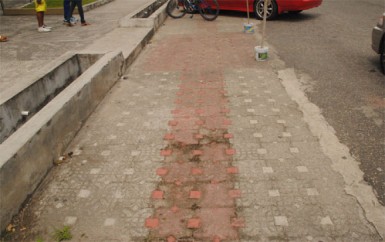In a year when the Ministry of Housing-sponsored International Building Expo reflected few if any new developments in the manufacturing sector, BK Quarries Inc, a subsidiary of the BK Group of Companies, is promoting a relatively new product.
BK International already operates the largest known quarrying site in the Caribbean on the bank of the Mazaruni River. That apart, the company has carved out impressive niches in Guyana’s housing, road construction and sea defence sectors.
Some years ago, on the recommendation of one of its engineers, the BK subsidiary produced a new, particularly sturdy hollow block for the construction sector that excludes the use of sand, an essential ingredient in the production of conventional concrete blocks.

The origin of the BK hollow block is located in the company’s quarrying operations at Mazaruni. Rock, like minerals, is found underground beneath up to ten feet of overburden. To be removed and reduced in size it has to be blasted. The reduced pieces, boulders, are used primarily in the country’s sea defence sector.
Beyond satisfying the needs of the sea defence sector BK’s operations also provides smaller sizes of stone, produced through various crushing processes. The initial crushing exercise produces a reduced size of stone described in the trade as underlay. Secondary and tertiary crushing exercises progressively reduce quantities of the stone further. In essence, the company has the capacity to produce quantities of various sizes of stone.
What BK International has sought to do is to ensure minimal waste from its quarrying operations and it is essentially from this policy that its hollow block production has arisen. After the tertiary process of reducing the rocks is completed what is left is a combination of what is known as ‘two-inch minus’ and sifting. Combined, the two form a mixture known as ‘first grade crusher run’. First grade crusher run has been tested and has proven to be an excellent base material for the road-construction industry. Along with sand and loam, crusher run forms a base that is topped by three quarter inch stone. The road is then topped with asphalt. The product has already been used on roads at
Timehri, Black Bush Polder, Providence, Mocha and Diamond.
It is the proven durability of the crusher run in the road construction sector that appears to have given birth to the use of the material in the manufacture of the company’s hollow blocks.
Last Friday, BK took its product to the International Building Expo as part of what the company says is a marketing drive that seeks to catch the eye of the local construction sector.
It was an experimental test by an engineer that gave birth to the new hollow block. Sifting, the ‘quarter inch minus’ end product of the process of reducing the boulders is the key component in the manufacture of the blocks. The key consideration is its role as a replacement – a far more sturdy and reliable replacement – for sand. Its selling point, the company said, is that unlike the conventional hollow blocks made with sand, the BK hollow block will not break or collapse easily.
The BK blocks are manufactured in 4, 6 and 8-inch sizes and can be used after a three-day production process. Produced in the company’s US$600,000 concrete Ready Mix automated batching plant and a hollow block plant, the facility turns out 6 blocks every 60 seconds.
The sifting is poured into a bin and conveyed to a sifter where the stone is removed. Cement and water are added and the mixture is moved via a conveyor to the moulds where the blocks are formed. The blocks are then removed manually and placed in the sun to dry. The company says that while its hollow blocks cost more than the conventional ones – a 6” BK block costs around $240 – their sturdiness makes them more economical.
Several homeowners are reportedly already attracted to the blocks. Additionally, the New Building Society and the Guyana Bank for Trade and Industry at Lethem have already used the block for building purposes. In the latter case the blocks have been used on a paved surface outside the building. The pavement blocks are being produced in two colours, red and grey.




